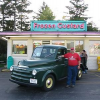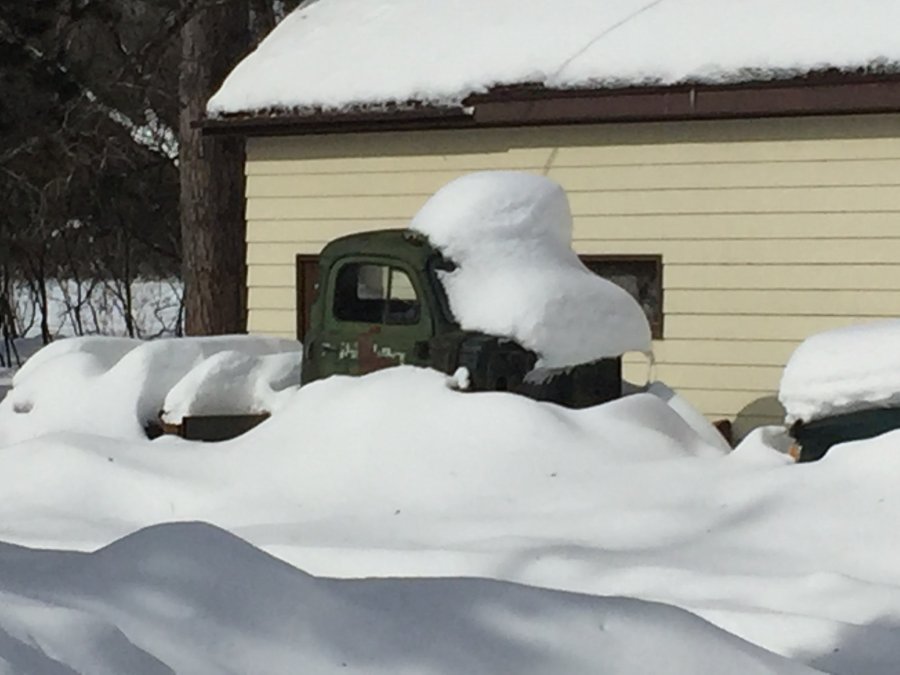-
Posts
9,394 -
Joined
-
Last visited
-
Days Won
87
Content Type
Links Directory
Profiles
Articles
Forums
Downloads
Store
Gallery
Blogs
Events
Everything posted by Merle Coggins
-

Roxanne - She don't have to put on the red light.
Merle Coggins replied to FlashBuddy's topic in Mopar Flathead Truck Forum
The red and black one is Ed's '46 Dodge. The other one is an International. The cabs did change considerably in '48 with the introduction of the B-Series. They got wider for one thing. Then the added rear corner windows (opitonal) for increased visibility. -
I don't see a little square. I see a "wink" emoji. ?
-

Sticking valve in a rebuilt motor
Merle Coggins replied to 41/53dodges's topic in Mopar Flathead Truck Forum
I had this same problem the first few years after I got my truck together. It always seemed to rain a lot between uses and every time I'd try to start it up it would crank funny and be very hard to start. I quickly realized that sticky valves was the problem. Once I would finally get it to start it would run rough for several minutes then gradually smooth out. I tried adding MMO to the gas, when I'd remember. I can't say if that really helped or not. I have not experienced that anymore in the past few years, so maybe it had something to do with it. Or things are just wearing in now. -

Internal vs External Coolant Bypass
Merle Coggins replied to Jocko_51_B3B's topic in Mopar Flathead Truck Forum
True, a small amount could bypass the radiator via the “bypass” port but it isn’t enough to cause any problems. -
You could always use a thermal bypass system. I see these often in hydraulic oil coolers on heavy equipment. It's essentially a simple relief valve that will open and allow oil to bypass the oil cooler when the back pressure through the cooler it too high, for example when oil is cold and thick.
-
As I watched that I was thinking, "They are idiots for standing so close." And I was right...
-
How hot is your oil getting? Many larger diesel engines have engine oil coolers built in to the cooling system, but a typical automotive engine shouldn't need it unless you're pushing it to extremes, as in racing. The oil needs to reach a normal operating temperature of 180-190 degrees F for any trapped moisture to be expelled. Otherwise you get what you show in the bottom picture... sludge buildup. If your oil is approaching 200 degrees, or more, then you should consider adding an oil cooler.
-

Assistance With Parts Clarification - Tie Rod Ends
Merle Coggins replied to keithb7's topic in P15-D24 Forum
I put your RH part number into Napaonline's search field and selected "Interchange". It came back with Part #: RPC 25263 from Rare Parts at $122 each. Yikes!! ? -

Thermostat Housing Problem
Merle Coggins replied to Jocko_51_B3B's topic in Mopar Flathead Truck Forum
- 19 replies
-
- 1
-

-
- thermostat housing
- thermostat housing problem
- (and 5 more)
-
That loose red wire appears to be going to the 30 terminal of the relay. This would be the power feed to the switch part of the relay. The light green wire coming off the middle-front terminal would be the 87 terminal, or Normally Open contact of the switch, which would get powered up from that red wire when the relay is activated. You say one terminal has no wire... That is likely the center terminal, or the 87a, which is the Normally Closed contact of the switch. This would have power from the 30 terminal until the relay gets activated, then the power would go away. The short red wire going to the mounting screw is the ground for the coil part of the relay, and the light green on the bottom, opposite the ground wire, is the activation wire for the coil. (85 and 86 respectively) So, as stated earlier, the light green wires are the key to what this relay is for. If one goes to the headlight and the other to the headlight switch, then someone added the relay to take the amperage load off of the switch. Either way, to make it function that loose red wire needs to be connected to a voltage source. It was most likely connected to the battery side of the starter relay. I would recommend adding a fuse to that wire when reconnecting it, to protect the circuit. Just a side note, but I wouldn’t use red wires for grounds. Red wires typically signify a hot wire, and black is typically used for grounds. I see there is another red ground wire attached at the top right corner of the picture.
-
Rather than putting a bigger fuse into the ignition switch feed, you'd be better served to put a relay, or 2, in after the key to feed your accessories. You could then fuse the relays to a higher amperage and keep the amp load through your switch to a minimum. Plus, what size wires are feeding in and out of that switch? Could they handle that higher amp load?
-
Not mine, but I saw it yesterday while I was out and about in far northern Wisconsin. I posted it on the Pilot House Facebook page and the owner spoke up. He was also in that group. Are you here too? I believe he said its a B1KA. The rest of it is in the shop for repairs.
-

1941 Dodge 2 1/2 ton Truck - New Fuel Pump
Merle Coggins replied to Duffy's topic in Mopar Flathead Truck Forum
I second that... Contact Then and Now Automotive. They have great fuel pump rebuild kits, and they are fairly simple to rebuild. You may need to get the failed one out so that you can identify the exact model. And if you can’t find any identifying marks, take pictures of it and contact them about it. They’ll be able to identify which kit you’ll need. Both kits I’ve purchased from them had retaining clips on the pin. Most “off the shelf” replacement pumps have a pressed in pin that tends to walk out over time. Rock Auto may have a listing for one for your truck, but I would rather have one rebuild with one of Then and Now’s kits than purchase a new one. http://www.then-now-auto.com/fuel-pumps/ -
I just measured up the length I figured I’d need, then went over to the local True Value Hardware store and rummaged through their spring drawers and found one that looked like it would work... And it seems to be working just fine.
-
I also believe you are right about the thrust adjustment. And I would suspect a loose, or failed, pinion bearing caused the gouges on the differential case. If they aren't loose now, it may have been a previous failure that was corrected.
-
The 2 times I was at Barber was for a conference in Birmingham, with Volvo Construction Equipment. They took us to Barber for a banquet on the last day. They set up a dining room up on the 3rd floor and served a wonderful banquet. We had a couple hours to roam the museum before dinner. Otherwise it would be quite a trip down there for me. Sounds like that vintage bike event would be fun though. Davenport (I’m assuming Iowa) would be much closer. May need to check that one out... As for Wheels Through Time, When Volvo CE had their North America Headquarters in Asheville, NC I would have to go there a couple times a year for training. Whenever possible I would ride my motorcycle down there and hopefully find a little extra time to do a little extra riding in the area. However, I never seemed to find that extra day in the trip to swing into Maggie Valley to see the museum,even through I’d pretty much be driving right past it. Now Volvo CE has moved their headquarters to Shippensburg, PA. So I don’t get down there like I used to. I may need to make it a point to take a vacation trip back down there with that place specifically in mind.
-
Or a broken axle shaft.
-
Yea, you all have it rough down there... ?
-
I was going through some pictures in my computer and found this one. Not the best to show overall fit. I think I took this to show CCC why it needed mirror pockets. You can sort of see in the picture how it fits the cab rather well. I used this in the summer months because it would sit in my driveway, so I could get my motorcycle in and out of the garage easier. Now that I have moved, and have a larger garage, it gets to stay inside now. I cut up a couple tennis balls and screwed them to pieces of dowel that I would slide into the top bed roll to soften the corners at the back. And that held well, but after about 3 summers of use the hood ornament started to poke through. This is why I wanted to reinforce that area.
-
It's a pretty impressive place... 3 floors of motorcycles, and they still have to stack them up... They had just opened a new wing addition when I was there last spring. I'm sure that's all full now. There wasn't much in it yet last March, but they say that they have at least as many bikes in storage as what's shown in the museum. And they claim that they all run and could be taken out for a ride.
-
-
I've been wanting to visit that museum for many years, but haven't had a chance yet. I used to get down to Asheville often, but I don't get down there much anymore. It's still on my Bucket LIst though. I have been to the Barber Motorsports Museum a couple of times. There are so many cool vintage bikes there it's hard to take it all in, but I did get a pic of this '35 Crocker Speedway on one visit.
-
I had one from California Car Covers that fit pretty good. I only wished that it had mirror pockets. After a few years of use it got a couple of rips in it. One from the hood ornament poking through the front. I ordered a replacement and asked for extra material to reinforce that spot. I also asked for extra material to make mirror pockets. They gladly accommodated me, and even offered that they would sew in mirror pockets if I marked it out and sent it back to them. I never got around to doing that, and now it has an indoor living space, so I don’t use it anymore. I would highly recommend California Car Covers.
-

Fuel Line Routing Question
Merle Coggins replied to Jocko_51_B3B's topic in Mopar Flathead Truck Forum
Yes, the fuel like runs up the left side frame rail, follows the lower rear flange of the front cross member over to the right side, then up to the fuel pump.



